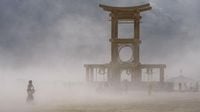Burning Man, the iconic weeklong festival held annually in Nevada’s Black Rock Desert, faced a dramatic and tumultuous opening weekend in 2025 as fierce dust storms, searing heat, and looming threats of rain and flooding battered attendees and organizers alike. What began as a celebration of art, radical self-expression, and community quickly turned into a test of endurance and adaptability amid some of the harshest weather conditions the event has seen in recent years.
According to the National Weather Service, warnings about a fast-moving “wall of blowing dust” were issued in advance of the festival’s opening weekend, which kicked off on August 22, 2025. Despite these alerts, thousands of “Burners” descended on Black Rock City, the temporary metropolis built each year for the festival, only to find themselves in the midst of a relentless dust storm. As reported by SFGate and Axios, the storm brought sustained winds reaching 45 to 50 mph, with gusts strong enough to rip apart campsites, dismantle intricate art installations, and send tents and belongings flying across the playa.
Social media quickly filled with images and videos of whiteout conditions, with festival-goers scrambling to secure their gear or seeking shelter in whatever RVs or vehicles had space. In one widely shared clip, men desperately tried to weigh down metal poles as the wind threatened to drag them away. “50 mile an hour sustained wind for over an hour with higher gusts. The desert is always trying to kill you,” one attendee wrote on Facebook, echoing the sentiments of many on the ground who described the experience as “definitely the scariest” they’d ever had at Burning Man, according to NBC News.
The havoc wreaked by the storm was not limited to personal belongings. One particularly poignant loss was the destruction of the “Black Cloud,” an 8-ton inflatable sculpture created by a group of Ukrainian artists. Intended to symbolize the threat of global war, the installation was torn apart by the wind, a stark reminder of both the festival’s artistic ambitions and the unforgiving desert environment.
As the storm intensified on Saturday, August 23, festival organizers made the difficult decision to close the gates to Black Rock City. No vehicles were allowed in or out, and flights to and from the area were halted. Officials urged everyone to stay off the roads, and those already inside were advised to “batten down the hatches, take care of your camp, and do not drive,” as relayed by the official Burning Man traffic account on X (formerly Twitter). For many, this meant hunkering down in makeshift shelters or RVs, watching helplessly as the elements battered their temporary homes.
The closure of the gates led to significant travel disruptions. By Monday morning, August 25, as the worst of the dust storm abated and the gates reopened, drivers heading into Black Rock City faced grueling delays of six to eight hours just to cover the eight-mile stretch from the main road to the festival entrance, according to Axios and festival organizers. The scene was one of frustration and exhaustion, but also of resilience—Burners emerged early to begin repairing their camps and retrieving scattered belongings, determined to keep the spirit of the event alive despite the setbacks.
Yet, the weather challenges were far from over. Meteorologists from the National Weather Service and AccuWeather warned that thunderstorms, rain, and even minor flooding could affect Black Rock City from Monday evening through at least Wednesday, August 27. The forecast called for “monsoonal moisture” that could spark additional hazards, including flash floods. The dusty lake bed of the playa, notorious for transforming into a muddy expanse with even modest rainfall, remained under close watch. Organizers and attendees alike braced for the possibility of a repeat of 2023, when heavy rains stranded thousands in thick mud and forced a shelter-in-place order—an event that resulted in one death and widespread logistical headaches.
The volatile weather was not limited to Nevada. As reported by the Los Angeles Times, the same monsoonal surge that battered Burning Man also brought rare August rain to Yosemite Valley, with over two inches falling at higher elevations, and sparked lightning strikes that ignited several small fires across California’s interior and the northern Sierras. The U.S. Forest Service recorded more than 10,000 lightning strikes within a 24-hour period over the weekend, though aggressive firefighting efforts kept most blazes small. The largest, the Garnet fire in Sierra National Forest, had burned almost 4,500 acres by Monday morning. Flood watches were issued for Yosemite, Sequoia and Kings Canyon National Parks, Mammoth Lakes, and the Sierra foothills, highlighting the regional scale of the weather’s impact.
Despite the chaos, the festival’s resilient community pressed on. Burning Man, which began in 1986 as a small gathering on San Francisco’s Baker Beach, has grown into a sprawling experiment in creativity, community, and radical self-reliance. This year, organizers expected around 70,000 to 80,000 participants, a figure that includes not just artists and free spirits but also billionaires, tech elites, and curious newcomers. The event’s evolution has sparked debate about its changing character, but the shared hardships of the desert—especially during moments like this—often serve to reinforce the bonds among attendees.
Not all the news from the playa was weather-related. At least one arrest was reported during the festival’s opening days, with a man caught attempting to smuggle mushrooms, LSD, and crack into the event, according to SFGate. Such incidents, while not uncommon at large gatherings, serve as reminders of the challenges organizers face in maintaining safety and order amid the festival’s ethos of radical freedom.
As the festival continues through September 1, 2025, participants remain on alert for further weather disruptions. Organizers have urged everyone to stay informed, heed official advisories, and prioritize safety—lessons hard-earned over decades in the unforgiving Black Rock Desert. For many Burners, the storms and setbacks are part of the experience, a crucible that tests the limits of endurance and community. As one festival spokesperson put it, “The desert is always trying to kill you”—a sentiment that rings especially true this year, but also speaks to the spirit that keeps people coming back, year after year, no matter what the weather brings.
For now, as Black Rock City rebuilds and the art rises anew from the dust, the festival’s unique blend of creativity, chaos, and camaraderie endures—weathering, quite literally, every storm.

